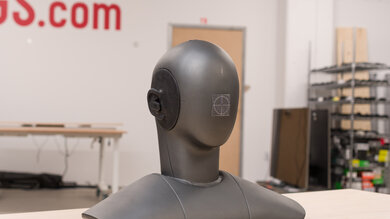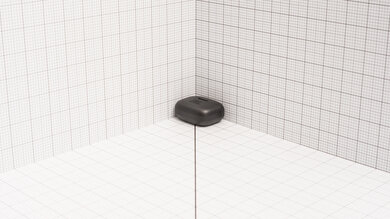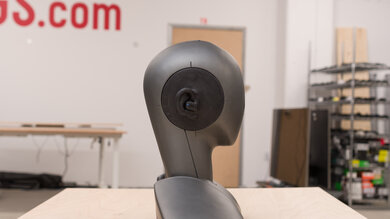The JBL Tune 130NC TWS Truly Wireless are the next generation of the JBL Tune 125TWS Truly Wireless. These wallet-friendly buds have a leg up on their predecessor, thanks to their companion app support, noise cancelling (ANC) system, and better build quality. However, for their price, they don't block out quite as much background noise as similarly-priced competitors like the Anker Soundcore Space A40 Truly Wireless.
Our Verdict
The JBL Tune 130NC are good for neutral sound. Out of the box, they have a very neutral sound profile suitable for various audio content. Although their mid-treble is slightly underemphasized, you can adjust their sound using their companion app's parametric EQ and presets. Unfortunately, since they're in-ear headphones, sound seems like it's coming from inside your head rather than from speakers placed in the room around you, which doesn't sound very immersive.
- Well-built and comfortable.
- Consistent audio delivery.
- Parametric EQ and presets available.
- Terrible passive soundstage.
The JBL Tune 130NC are good for commuting and travel. They have a small and lightweight design, making it easy to put them into your pockets or bags when you're on the go. They also have a comfortable fit and deliver over seven hours of continuous battery life. If you need to top them up, their carrying case supplies three additional charges. However, their ANC struggles to block out bus and plane engine noise.
- IPX4 rating for water resistance.
- Well-built and comfortable.
- Consistent audio delivery.
- ANC struggles to block out bass-range noise.
The JBL Tune 130NC are great for sports and fitness. They have a comfortable, lightweight, and well-built design rated IPX4 for resistance against water splashes. They also have roughly 7.6 hours of continuous battery life, which will last through days on the move. They lack stability fins and can fall out of your ears with more intense head movement.
- IPX4 rating for water resistance.
- Well-built and comfortable.
- Terrible passive soundstage.
The JBL Tune 130NC are decent for office use. These headphones have a comfortable fit and a 7.6-hour continuous battery life with three extra charges in the case. They also don't leak a lot of audio at high volumes, so you can turn your music up without bothering your coworkers. They have active noise cancelling and can block out an excellent amount of office chatter around you. However, you can't connect them to your PC and smartphone simultaneously.
- Well-built and comfortable.
- Excellent at blocking out ambient chatter.
- No multi-device pairing.
- Terrible passive soundstage.
The JBL Tune 130NC TWS can't connect to PlayStation or Xbox consoles, and their latency with PCs, iOS, and Android devices is too high to be suitable for gaming. That said, they have a low-latency 'Video Mode', which helps lower their audio lag within reasonable levels on iOS and Android devices. It's handy if you're into mobile gaming.
The JBL 130NC are Βluetooth-only headphones, and you can't use them wired.
The JBL Tune 130NC are okay for phone calls. Their integrated mic offers a satisfactory recording quality, ensuring your voice is intelligible to whoever you're talking to. However, it struggles to separate your voice from moderate ambient noise around you, and your voice can be drowned out if you're taking a call from a busy street.
- Well-built and comfortable.
- Satisfactory recording quality.
- No multi-device pairing.
- Mic struggles to separate your voice from moderate noise around you.
Check Price
Differences Between Sizes And Variants
The JBL Tune 130NC TWS come in three color variants: 'Blue', 'White', and 'Black'. We tested the 'Black' variant; you can see our model's label here. If you encounter another variant, please let us know in the forums.
Popular Headphones Comparisons
The JBL Tune 130NC are the next generation of the JBL Tune 125TWS Truly Wireless and have a more comfortable and well-built design. Unlike their predecessor, they also have ANC. Although it offers an okay overall performance, it falls short compared to other truly wireless headphones like the EarFun Air Pro 2 True Wireless or the Anker SoundCore Life P3 Truly Wireless. That said, they offer a very neutral sound profile and, like many JBL headphones, have a companion app with a parametric EQ and presets.
Check out our recommendations for the best true wireless earbuds, the best noise cancelling earbuds and in-ear headphones, and the best earbuds and in-ear headphones.
The Apple AirPods Pro are better in-ears than the JBL 130NC TWS Truly Wireless. While both headphones are comfortable, the Apple are better built, have a better noise isolation performance, and have an H1 chip for seamless pairing with your other Apple devices. However, the JBL have a more neutral and customizable sound profile. Their continuous battery life is longer too.
The JBL Tune 130NC TWS Truly Wireless are similarly performing in-ears as the JBL Tune 230NC TWS True Wireless. While both headphones are comfortable and well-built, the 230NC have a more stable in-ear fit and better battery performance. The 130NC have a more neutral default sound profile, which some users may prefer, and their ANC can block out more ambient noise.
The Jabra Elite 7 Pro True Wireless are better overall headphones than the JBL Tune 130NC TWS Truly Wireless. While both headphones are comfortable and well-built, the Jabra have a more stable in-ear fit, are equipped with an ANC system, and their default sound profile is even more neutral, which some users may prefer. They also have a slightly better battery performance.
Depending on your usage, you may prefer either the Beats Solo Pro or the JBL Tune 130NC TWS Truly Wireless. The Beats are on-ear headphones that are better built, have a significantly better noise isolation performance, and have longer continuous battery life. They also have an H1 chip to seamlessly pair them with your Apple devices. However, the JBL are in-ears that are more comfortable and have a more neutral default sound profile that you can adjust to your liking using their companion app's parametric EQ and presets.
Test Results

These in-ears have a non-descript look, with the manufacturer's logo on both buds in a large, glossy print. They're also a bit bulky and stick out of your ear like similarly oval-shaped earbuds like the JBL Tune 125TWS Truly Wireless and Bose QuietComfort Earbuds Truly Wireless. They come in three colors: 'Black', 'White', and 'Blue'.
There's a touch-sensitive surface on each bud, which is easy to use and responsive. There are beeps to let you know when you've registered a command, and an audible tone to let you know when you're pairing as well as cycling between ANC on, 'Ambient Sound Control', and ANC off. You can also remap the controls to add volume and voice assistant commands. On the downside, if you want to use one bud while the other bud is charging, you'll lose some access to controls. In addition, there are no volume controls by default, so if you want them, you'll need to add the command via the companion app.
On the left earbud:
- Single tap: Cycle between ANC on, 'Ambient Sound Control', which allows you to better hear your environment without taking the headphones out of your ears, and ANC off.
- Double tap: Turns 'TalkThru' on and off. This feature lowers your media's volume and enables 'Ambient Sound Control' so that you can have conversations.
On the right earbud:
- Single tap: Plays and pauses audio.
- Double tap: Skips to the next track.
- Triple tap: Skips to the previous track.
On either earbud:
- Double tap: Answers and ends calls.
- Tap and hold: Activates voice assistant. Also rejects a call. When you're on a call, this function mutes and unmutes your microphone.
These headphones come with a decent carrying case. It's nearly identical in design to that of the JBL TUNE 230NC TWS True Wireless, although the inner molding is designed to fit these specific earbuds. It's also made of plastic but feels cheap overall. The lid especially feels flimsy compared to the case's body. It has magnets to hold the buds in place, and LED lights display the case's battery life.
These buds have a good build quality. They're mostly made of plastic, although it feels a bit cheap. The ear tips also feel thin and could be a weak point of the build. However, they still feel solid enough to survive several accidental drops without taking too much damage. They're also rated IPX4 for protection against water splashes, which is good if you want to use them during a run in the park.
Out of the box, these headphones have a very neutral sound profile that ensures vocals and instruments sound clear and natural. As a result, their sound is well-suited for a variety of audio content. If you prefer a different sound, their companion app offers a parametric EQ and presets to adjust the sound to your liking.
These headphones have great frequency response consistency. Although there's a bit of deviation in the treble range, once you achieve an air-tight seal, they'll deliver audio consistently each time you use them.
The JBL Tune 130NC have outstanding bass accuracy. The range is fairly flat and neutral, resulting in thump, rumble, and body. A small dip in the high-bass slightly lowers their boom and warmth, but it's fairly minor.
The mid range is exceptional. This range is also very flat and neutral. Vocals and lead instruments sound bright, clear, and accurate, although intense. In songs like Taylor Swift's Karma, voices are detailed and easy to follow.
These buds have excellent treble accuracy. The low-treble is fairly neutral, so vocals and lead instruments are detailed. However, the mid-treble is underemphasized, so sibilants like S and T sounds are dull.
The JBL Tune 130NC's peaks and dips performance is excellent. Overall, there aren't many peaks and dips, meaning the headphones can follow their own sound profile well. Those present are also fairly minor in height or depth. There's a small mismatch between the left and right drivers, and some peaks and dips affect one driver more than the other. This happens most noticeably in the low-bass, as the left driver produces more thump and rumble than the right, and in the mid-treble, the left driver dulls sibilants like cymbals while the right driver makes them sound harsh.
JBL's products tend to have good imaging, partly due to the manufacturer's quality control and ergonomics, although there have been some misses. Although imaging varies across units, our unit's L/R drivers have a lot of phase mismatch that's audible with real-life content. This skews sound objects like instruments to one side of the stereo image. For example, the low-mid is louder in the right driver, while the high-mid to treble is louder in the left driver. That said, the peak in the high-bass is harder to spot. Conversely, group delay falls within good levels, resulting in tight bass and transparent treble reproduction. The drivers are also well-matched in frequency and phase response, which helps to ensure a stable image.
These headphones have a terrible passive soundstage, which is normal for in-ear headphones. To create an immersive and speaker-like passive soundstage, you need to activate your outer ear with sound. By design, they bypass your outer ear, and sound seems to be coming from inside your head rather than from speakers in the room around you. Since they also have a closed-back design, their soundstage won't seem as spacious as headphones with an open-back enclosure.
The weighted harmonic distortion performance is good. Although there are some peaks in the treble range, it can be hard to hear with real-life content. Most of the frequency range falls within good limits, resulting in mostly clean and pure audio reproduction.
These are the settings used to test these headphones. Our results are only valid when using them with these settings.
The noise isolation performance is okay. The ANC doesn't offer significantly better performance than the headphones' passive isolation capabilities, and overall, these headphones block out less noise than the JBL Tour Pro+ TWS True Wireless. As a result, they struggle to isolate you from the low rumble of bus and plane engines. While they do a better job of cutting down office chatter, high-pitched noise like the hum of an AC unit is more challenging for the ANC to reduce well.
The leakage performance is excellent. Leakage is mostly concentrated in the treble range, which sounds thin. However, if you like to listen to your favorite tracks at a high volume, you won't bother others around you.
The integrated mic has a satisfactory recording quality, and your voice sounds natural but thin and lacking in body. You won't have problems being understood clearly if you're speaking in a quiet space, though.
While the mic's recording quality is satisfactory, the noise handling performance is just okay. The mic has trouble separating your voice from moderate ambient sound around you. As a result, it may be difficult for whoever's on the other end of the line to hear you clearly if you're taking a call from a busy street.
The JBL Tune 130NC have a good battery performance. They're advertised to last roughly eight hours with their ANC on, but we measured a bit less than that. However, battery life can vary depending on use. Their carrying case holds roughly three additional charges, and they have an auto-off timer to help conserve battery life when you're not using them. You can also use one bud while the other one charges.
The JBL Headphones app is great. It allows you to adjust their sound using their parametric EQ and presets, turn on and off ANC, toggle between 'Ambient Aware', which allows you to stay aware of your surroundings without taking the buds out of your ear, and 'TalkThru', which lowers your audio and amplifies speech so that you can hold conversations without removing the buds, and remap controls. You can also toggle 'Smart Audio & Video' between the following settings: 'Normal' (for a stable connection), 'Audio Mode' (which is the default setting and is designed for the best sound for music), and 'Video Mode' (which lowers latency for streaming video). You can adjust the auto-off timer, turn the auto play/pause feature on and off, and access 'Find My Buds'.
The JBL Tune 130NC TWS have alright Bluetooth connectivity. Unfortunately, they don't support multi-device or NFC pairing. They also have high audio lag on PCs, iOS, and Android devices. However, their companion app has a low-latency 'Video Mode', which helps lower audio lag. It's still quite high on PCs but is much lower on iOS and Android devices, so you can stream video without severe lip-sync mismatch. That said, some apps and devices compensate for latency differently.
These headphones are fully compatible with Bluetooth-enabled PCs. However, you can't connect to a PC in any other way.















